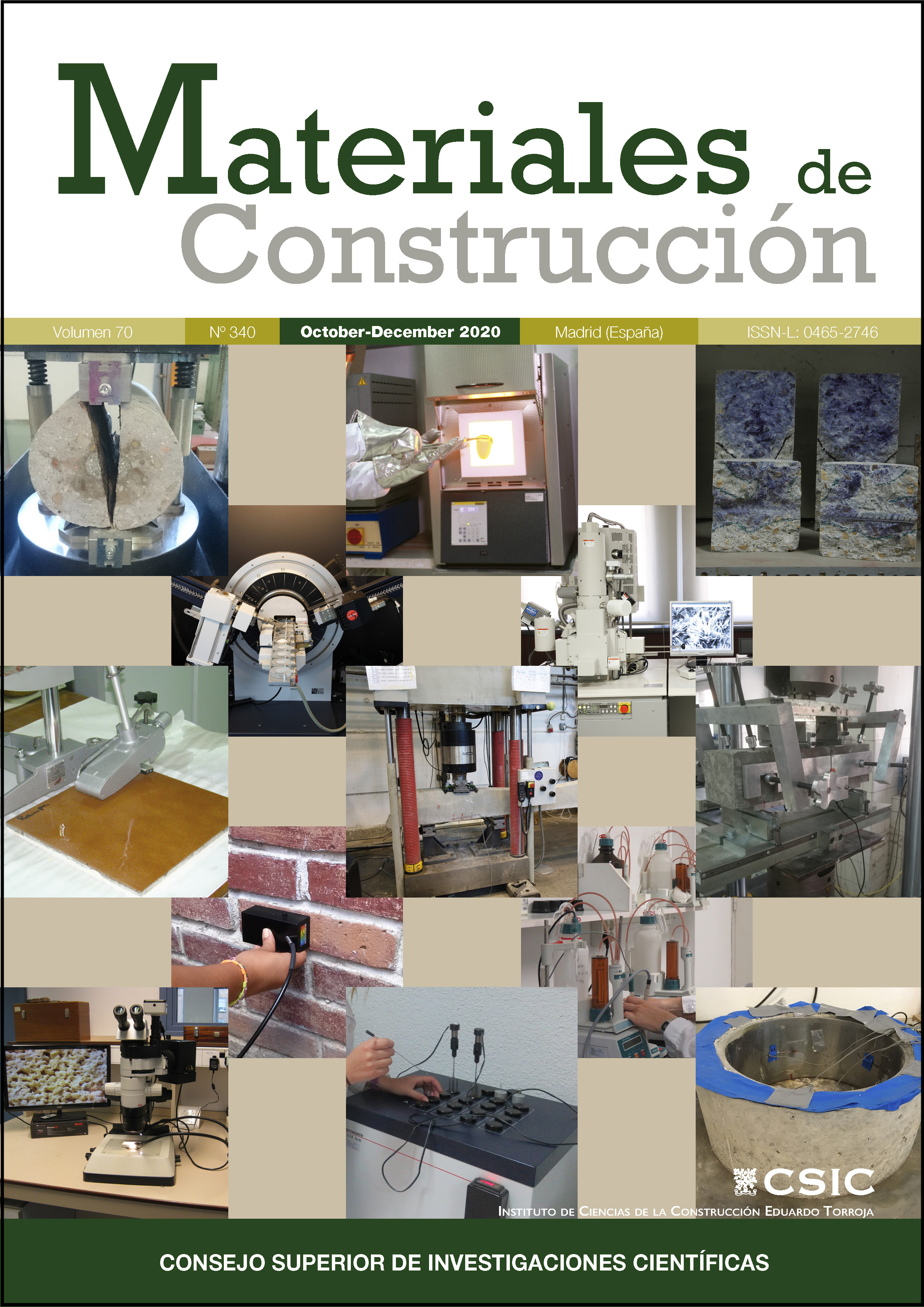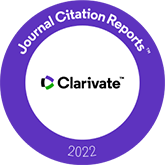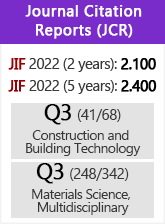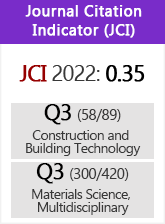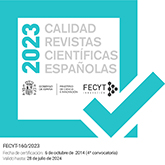Radioactivity of building materials in Mahallat, Iran – an area exposed to a high level of natural background radiation – attenuation of external radiation doses
DOI:
https://doi.org/10.3989/mc.2020.03820Keywords:
Building Material, HNBRA, Radiation assessment, Dose rate, Shielding effectAbstract
In this study, mass activity of naturally occurring radioactive materials were measured in twenty-three building material samples, use extensively in the area exposed to a high level of natural background radiation (Mahallat, Iran), to determine the radioactivity index and changes to the level of indoor gamma radiation. The mass activity of 232Th, 226Ra and 40K were within the ranges from 18 ± 3 to 44 ± 10 Bq/kg (average of 27 ± 6 Bq/kg), 22 ± 5 to 53 ± 14 Bq/kg (average of 34 ± 6 Bq/kg) and 82 ± 18 to 428 ± 79 Bq/kg (average of 276 ± 58 Bq/kg), respectively. The gamma dose rates for population were estimated between 48 ± 9 and 111 ± 26 nGy/h with exception of radon exhalation from building materials. Since the air kerma rate in the town varies from 0.8 to 4 μGy/h, the attenuation coefficient was calculated for buildings made of the aforementioned materials. Additionally, the annual gamma radiation doses for inhabitants were calculated based on time spent outdoors and indoors.
Downloads
References
United Nations Scientific Committee on the Effects of Atomic Radiation. (2000) Sources and effects of ionizing radiation. UNSCEAR 2000 report to the General Assembly, with scientific annexes. Volume I: Sources. United Nations Publications. New York, (2000).
The Council of European Union. 2014. Council directive 2013/59/EURATOM. OJEU. L13 [1], 1-73.
Kovács, T.; Szeiler, G.; Fábián, F.; Kardos, R.; Gregorič, A.; Vaupotič, J. (2013) Systematic survey of natural radioactivity of soil in Slovenia. J. Environ. Radioact. 122, 70-78. https://doi.org/10.1016/j.jenvrad.2013.02.007 PMid:23558252
Kardos, R.; Sas, Z.; Hegedűs, M.; Shahrokhi, A.; Somlai, J.; Kovács, T. (2015) Radionuclide content of NORM by-products originating from the coal-fired power plant in Oroszlány (Hungary). Radiat. Prot. Dosim. 167 [1-3], 266-269. https://doi.org/10.1093/rpd/ncv259 PMid:25944954
Aliyu, A.S.; Ramli, A.T. (2015) The world's high background natural radiation areas (HBNRAs) revisited: A broad overview of the dosimetric, epidemiological and radiobiological issues. Radiat. Meas. 73, 51-59. https://doi.org/10.1016/j.radmeas.2015.01.007
International Commission on Radiological Protection. (2007) The 2007 recommendations of the International Commission on Radiological Protection. Annals of the ICRP. 103.
Shetty, P.K.; Narayana, Y. (2010) Variation of radiation level and radionuclide enrichment in high background area. J. Environ. Radioact. 101 [12], 1043-1047. https://doi.org/10.1016/j.jenvrad.2010.08.003 PMid:20833457
Mortazavi, S.M.J.; Mozdarani, H. (2012) Is it time to shed some light on the black box of health policies regarding the inhabitants of the high background radiation areas of Ramsar? Iran J. Radiat. Res. 10 [3-4], 111-116.
Sohrabi, M.M.; Beitollahi, M.M.; Lasemi, Y.; Amin, S.E. (1996) Origin of a new high level natural radiation area in hot spring region of Mahallat, Central Iran. In Proceedings of the 4 th International Conference on High Levels of Natural Radiation. Vienna, (1996).
The Council of European Union. (1999) Radiation Protection 112: Radiological Protection Principles Concerning the Natural Radioactivity of Building Materials. Directorate-General, Environment, Nuclear Safety and Civil Protection. 5-16.
Nuccetelli, C.; Leonardi, F.; Trevisi, R. (2015) A new accurate and flexible index to assess the contribution of building materials to indoor gamma exposure. J. Environ. Radioact. 143, 70-75. https://doi.org/10.1016/j.jenvrad.2015.02.011 PMid:25743410
Karam, P.A. (2002) The high background radiation area in Ramsar Iran: Geology, Norm, Biology, LNT, and possible regulatory fun. University of Rochester. Rochester, NY, (2002).
Ghiassi-Nejad, M.; Mortazavi, S.M.J.; Cameron, J.R.; Niroomand-Rad, A.; Karam, P.A. (2002) Very high background radiation areas of Ramsar, Iran: preliminary biological studies. Health physics. 82 [1], 87-93. https://doi.org/10.1097/00004032-200201000-00011 PMid:11769138
Hendry, J.H.; Simon, S.L.; Wojcik, A.; Sohrabi, M.; Burkart, W.; Cardis, E.; Laurier, D.; Tirmarche, M.; Hayata, I. (2009) Human exposure to high natural background radiation: what can it teach us about radiation risks?. J. Radiol. Prot. 29 [2A], A29. https://doi.org/10.1088/0952-4746/29/2A/S03 PMid:19454802 PMCid:PMC4030667
Jayanthi, D.D.; Maniyan, C.G.; Perumal, S. (2011) Assessment of indoor radiation dose received by the residents of natural high background radiation areas of coastal villages of Kanyakumari district, Tamil Nadu, India. Radiat. Phys. Chem. 80 [7], 782-785. https://doi.org/10.1016/j.radphyschem.2011.03.011
Bavarnegin, E.; Fathabadi, N.; Moghaddam, M.V.; Farahani, M.V.; Moradi, M.; Babakhni, A. (2013) Radon exhalation rate and natural radionuclide content in building materials of high background areas of Ramsar, Iran. J. Environ. Radioact. 117, 36-40. https://doi.org/10.1016/j.jenvrad.2011.12.022 PMid:22280998
Sohrabi, M. (2013) World high background natural radiation areas: Need to protect public from radiation exposure. Radiat. Meas. 50, 166-171. https://doi.org/10.1016/j.radmeas.2012.03.011
Sahoo, S.K.; Žunić, Z.S.; Kritsananuwat, R.; Zagrodzki, P.; Bossew, P.; Veselinovic, N.; Mishra, S.; Yonehara, H.; Tokonami, S. (2015) Distribution of uranium, thorium and some stable trace and toxic elements in human hair and nails in Niška Banja Town, a high natural background radiation area of Serbia (Balkan Region, South-East Europe). J. Environ. Radioact. 145, 66-77. https://doi.org/10.1016/j.jenvrad.2015.03.020 PMid:25875006
Mubarak, F.; Fayez-Hassan, M.; Mansour, N.A.; Ahmed, T.S.; Ali, A. (2017) Radiological Investigation of High Background Radiation Areas. Sci. Rep. 7, 15223. https://doi.org/10.1038/s41598-017-15201-2 PMid:29123148 PMCid:PMC5680266
Pérez, M.; Chávez, E.; Echeverría, M.; Córdova, R.; Recalde, C. (2018) Assessment of natural background radiation in one of the highest regions of Ecuador. Radiat. Phys. Chem. 146, 73-76. https://doi.org/10.1016/j.radphyschem.2018.01.002
Okeyode, I.C.; Oladotun, I.C.; Alatise, O.O.; Bada, B.S.; Makinde, V.; Akinboro, F.G.; Mustapha, A.O.; Al-Azmi, D. (2019) Indoor gamma dose rates in the high background radiation area of Abeokuta, South Western Nigeria. J. Radiat. Res. Appl. Sci. 12 [1], 72-77. https://doi.org/10.1080/16878507.2019.1594097
Bé, M.-M.; Chechev, V.P.; Dersch, R.; Helene, O.A.M.; Helmer, R.G.; et al. (2007) Update of x ray and gamma ray decay data standards for detector calibration and other applications, volume 2: data selection assesment and evaluation procdures. International Atomic Energy Agency. Vienna, (2007).
Shahrokhi, A. (2018) Applicaton of the European basic safety standards directive in underground mines: a comprehensive radioecology study in a Hungarian manganese mine. PhD thesis, Pannon Egyetem. Veszprém, (2019).
Adelikhah, M.; Shahrokhi, A.; Chalupnik, S.; Tóth-Bodrogi, E.; Kovács, T. (2020) High level of natural ionizing radiation at a thermal bath in Dehloran, Iran. Heliyon. 6 [7], e04297. https://doi.org/10.1016/j.heliyon.2020.e04297 PMid:32642584 PMCid:PMC7334375
Shahrokhi, A.; Szeiler, G.; Rahimi, H.; Kovács, T. (2014) Investigation of natural and anthropogenic radionuclides distribution in arable land soil of south eastern European countries. Int. J. Sci. Engineer. Res. 5 [11], 445-449.
El-Mageed, A.I.A.; Farid, M.E.A.; Saleh, E.E.; Mansour, M.; Mohammed, A.K. (2014) Natural radioactivity and radiological hazards of some building materials of Aden, Yemen. J. Geochem. Explor. 140, 41-45. https://doi.org/10.1016/j.gexplo.2014.01.015
Shoeib, M.Y.; Thabayneh, K.M. (2014) Assessment of natural radiation exposure and radon exhalation rate in various samples of Egyptian building materials. J. Radiat. Res. Appl. Sci. 7 [2], 174-181. https://doi.org/10.1016/j.jrras.2014.01.004
Wang, Q.; Song, J.; Li, X.; Yuan, H.; Li, N.; Cao, L. (2015) Environmental radionuclides in a coastal wetland of the Southern Laizhou Bay, China. Mar. Pollut. Bull. 97 [1-2], 506-511. https://doi.org/10.1016/j.marpolbul.2015.05.035 PMid:26028169
Trevisi, R.; Risica, S.; D'Alessandro, M.; Paradiso, D.; Nuccetelli, C. (2012) Natural radioactivity in building materials in the European Union: a database and an estimate of radiological significance. J. Environ. Radioact. 105, 11-20. https://doi.org/10.1016/j.jenvrad.2011.10.001 PMid:22230017
Malanca, A.; Pessina, V.; Dallara, G. (1993) Radionuclide content of building materials and gamma ray dose rates in dwellings of Rio Grande Do Norte, Brazil. Radiat. Prot. Dosim. 48 [2], 199-203.
Dabayneh, K.M. (2007). Radioactivity measurement in different types of fabricated building materials used in Palestine. Arab J. Nuclear Sci. Applic. 40 [3], 208-219.
Lu, X.; Chao, S.; Yang, F. (2014) Determination of natural radioactivity and associated radiation hazard in building materials used in Weinan, China. Radiat. Phys. Chem. 99, 62-67. https://doi.org/10.1016/j.radphyschem.2014.02.021
Rafique, M.; Rahman, S.U.; Basharat, M.; Aziz, W.; Ahmad, I.; Lone, K.A.; Ahmad, K.; Matiullah, K. A. (2014) Evaluation of excess life time cancer risk from gamma dose rates in Jhelum valley. J. Radiat. Res. Appl. Sci. 7 [1], 29-35. https://doi.org/10.1016/j.jrras.2013.11.005
Taskin, H.; Karavus, M.; Ay, P.; Topuzoglu, A.; Hidiroglu, S.; Karahan, G. (2009) Radionuclide concentrations in soil and lifetime cancer risk due to gamma radioactivity in Kirklareli, Turkey. J. Environ. Radioact. 100 [1], 49-53. https://doi.org/10.1016/j.jenvrad.2008.10.012 PMid:19038480
Sohrabi, M.; Roositalab, J.; Mohammadi, J. (2015) Public effective doses from environmental natural gamma exposures indoors and outdoors in Iran. Radiat. Prot. Dosim. 167 [4], 633-641. https://doi.org/10.1093/rpd/ncu372 PMid:25602079
Shahrokhi, A.; Shokraee, F.; Reza, A.; Rahimi, H. (2015) Health risk assessment of household exposure to indoor radon in association with the dwelling's age. J. Radiat. Protect. Res. 40 [3], 155-161. https://doi.org/10.14407/jrp.2015.40.3.155
Published
How to Cite
Issue
Section
License
Copyright (c) 2020 Consejo Superior de Investigaciones Científicas (CSIC)

This work is licensed under a Creative Commons Attribution 4.0 International License.
© CSIC. Manuscripts published in both the printed and online versions of this Journal are the property of Consejo Superior de Investigaciones Científicas, and quoting this source is a requirement for any partial or full reproduction.All contents of this electronic edition, except where otherwise noted, are distributed under a “Creative Commons Attribution 4.0 International” (CC BY 4.0) License. You may read here the basic information and the legal text of the license. The indication of the CC BY 4.0 License must be expressly stated in this way when necessary.
Self-archiving in repositories, personal webpages or similar, of any version other than the published by the Editor, is not allowed.
